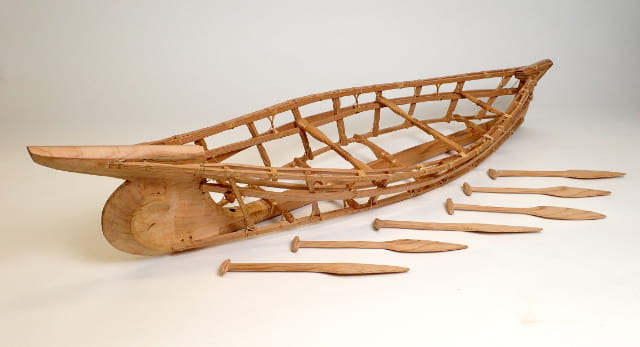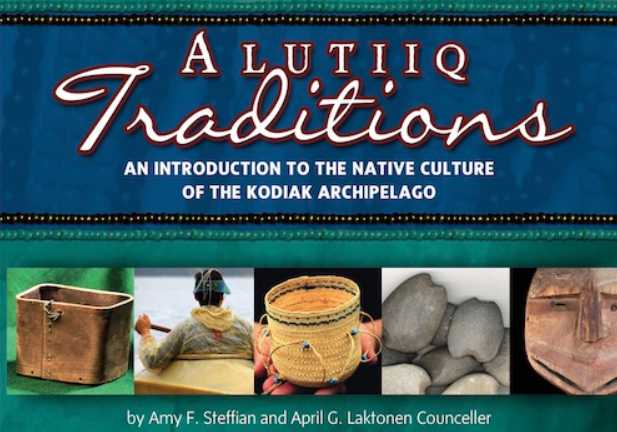 KODIAK, Alaska—The history of the Kodiak Alutiiq/Sugpiaq people is the subject of a new book released Wednesday by the Alutiiq Museum. The 188-page paperback, titled Imaken Ima’ut—From the Past to the Future, traces the history of Kodiak’s Native people over more than seven millennia. Written for a public audience, it provides an accessible account of Alutiiq history told by local scholars and with Alutiiq perspectives. It was funded by a grant to Koniag by the Institute for Museum and Library Services.
KODIAK, Alaska—The history of the Kodiak Alutiiq/Sugpiaq people is the subject of a new book released Wednesday by the Alutiiq Museum. The 188-page paperback, titled Imaken Ima’ut—From the Past to the Future, traces the history of Kodiak’s Native people over more than seven millennia. Written for a public audience, it provides an accessible account of Alutiiq history told by local scholars and with Alutiiq perspectives. It was funded by a grant to Koniag by the Institute for Museum and Library Services.
“A few years ago, the museum held a tribal summit where we shared Alutiiq history,” said April Laktonen Counceller, the Alutiiq Museum’s executive director and one of the book’s authors. “We gave presentations to delegates from ten tribes and then asked what the museum should be sharing. Up to that point, we’d focused on teaching about Alutiiq traditions and had not delved into recent history. Many people were surprised by what they learned and everyone urged us to tell a fuller Alutiiq story. That discussion was part of the impetus for this book.”
Four museum staff members wrote, edited, and designed the five-chapter publication. It begins with a discussion of the importance of tribal histories and the sources of information used to build the book. Then, the authors explore the Alutiiq past. Two chapters written by museum archaeologists Patrick Saltonstall and Amy Steffian look at Kodiak’s deep human history, synthesizing information on the peopling of the archipelago and the evolution of ancestral cultures. Then Alutiiq scholar Dehrich Chya shares the Russian conquest of Kodiak. He considers the economic, educational, and spiritual forces that dramatically altered Alutiiq life over a tumultuous century. Counceller continues this investigation with a review of the American era. She considers how Western industries, educational systems, and policies impacted the Alutiiq after the Alaska purchase, and then traces the development of the Alutiiq cultural renaissance from its roots in the land claims era to the present. Both Chya and Counceller provide Native perspectives on events that have often been told through Western accounts.
The presentation is heavily illustrated with over two hundred images from the museum’s collections and numerous sidebars. The sidebars share short summaries of related information. For example, in a discussion of the fur trade, readers will find a sidebar about Alutiiq hunters taken to California. Each chapter ends with a glossary of Alutiiq words and a list of references. The book ends with an introduction to its authors and a detailed index.
“We designed the book to be engaging and accessible,” said Counceller. “It is carefully researched by our team and then presented in a way that makes the information understandable. We believe it will be a valuable resource for Alaska history classes. Imaken Ima’ut brings Alutiiq history to life, and we know that’s important for Native youth. Our children do better in school when they see their heritage reflected in their lessons.”
Copies of Imaken Ima’ut are being distributed for free to Kodiak schools, Native organizations, libraries, and the museum’s educational partners. On April 18th, free copies will be offered to the public at a presentation and book signing hosted by the Kodiak National Wildlife Refuge Visitors Center. The event will start at noon and provide books while supplies last. Additionally, a free downloadable eBook of Imaken Ima’ut is available on the publications page of the museum’s website (https://alutiiqmuseum.org/museum/publications/). Paper copies can be purchased from the Alutiiq Museum Store for $25.
The Alutiiq Museum is a non-profit organization dedicated to preserving and sharing the history and culture of the Alutiiq/Sugpiaq, an Alaska Native tribal people. Representatives of Kodiak Alutiiq organizations govern the museum with funding from charitable contributions, memberships, grants, contracts, and sales.
###[content id=”79272″]







